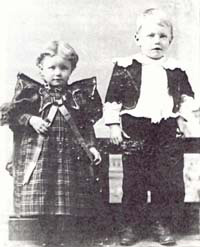
Geir (Kristjánsson) &
Sesselja Rakel Sveinsdóttir
Christianson
Editors Note:
This lively account
of homesteading in the Vatnbyggð settlement, the main Icelandic settlement in the province of Saskatchewan, was narrated by Halldóra (Dora) Bjarnason, daughter of Icelandic immigrants Geir Christianson (Kristjánsson) & Sesselja Rakel Sveinsdóttir.
For more on information on the migration experience of this family, please see the Dr. Sigridur (Sigga) Christianson Houston story.

"The Early Years on 32-32-16-W2," by the late Dora Bjarnason, as told to her nephew, C. Stuart Houston originally printed in Reflection by the Quills, used with permission.
Dora was born January 13, 1896 in Grand Forks, North Dakota, the third of four children born to Geir and Sesselja.The lure of free land at Vatnbygg [sic], the new Icelandic settlement, caused my father to bring us west to homestead in 1905.

Sigga and Bill
One morning in early July, my sisters Sigga and Babs and I arrived with Mama at the Wadena station at 5:00 AM. Our passenger train had passed the freight containing Dad and my older brother Bill and our settlers’ effects, but they arrived at 1:00 PM the same day.
Our belongings included two oxen named Bob and Charlie, twenty chickens in crates, a walking plow, a three-tiered wagon, and lumber for our house. In the freight car with Dad and Bill were two “stowaways,” the Sveinsons, father and son. The four men unloaded.
We trekked across the prairie at a snail’s pace. The oxen were fitted with harness collars, not yokes. We three girls were terrified when crossing creeks. There were miles and miles of open prairie—we could get out of the wagon and run about, and catch up again easily. We found a few strawberries, and a few prairie flowers that withered and died in our clasp.
The first night we stayed at the farm of Jon Oddson, midway to our homestead, and were fed supper and breakfast. The next day it was pouring rain. Mama and we three girls stopped off with Rakovel and Sophie Johnson, who lived two miles past Oddsons’. After the rain stopped, we followed the wagon in style in a democrat buggy and team driven by Valgerdur Sveinson, a cousin of Sophies’s.
Dad had borrowed a round tent from Paul Vestdal. We lived for six weeks in that tent, there was nothing in the tent but two large mattresses and the blankets. There were no chairs or tables, because I can remember poor Mama squatting in front of our tiny camp stove outside the tent. We had a few pots and pans and a few dishes. Mama made biscuits and scones, flat bread, cornmeal mush, and oatmeal. We had a few five-or ten-pound flat boxes of prunes and dried apples and dried apricots, used sparingly as a treat. We also had sugar, coffee, salt and pepper.
Meanwhile Dad bought a cow from a neighbour for forty dollars. Her udder was so big it reached almost to the grass, just like an Icelandic cow. Mama couldn’t possibly have made butter—there was not way to set the milk to get the cream off it. There was no dugout or cellar to keep anything cool. We drank the milk soon after the cow was milked.
I can recall a rainy spell when we huddled in the tent, damp, cold, and miserable. Since the men were not haying, Mama did what cooking she could under the wagon and the hayrack.
continue